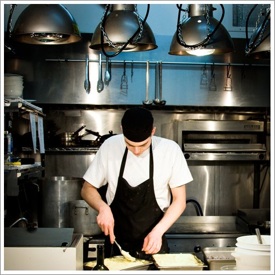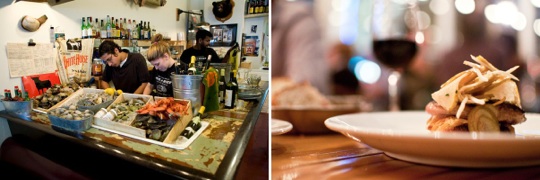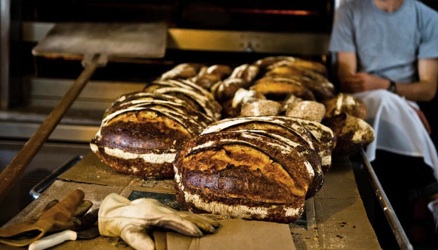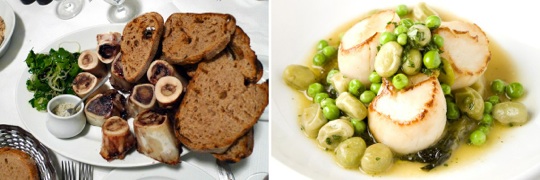Chef Marc Cohen, Montreal, Lawrence Restaurant, Quebec, QC, Canada, Ottawa, ON, Ontario, London, UK, United Kingdom, San Francisco, CA, California, Brooklyn, NY, New York, Where to eat, Where to drink, Where to shop, Markets, Restaurants, Bars, Coffee, Shops, Fergus Henderson, Nose To Tail, American, British, French, Joe Beef, David McMillan, Frederic Morin, Chef’s Recs



Lawrence
Mile End
British / French
5201 Boulevard St. Laurent
Montreal, QC H2T 2L9, Canada
T: 514.503.1070 (make a reservation)
Website:











Q & A



Who
Marc Cohen is the chef and co-owner of Lawrence in Montreal, QC.
Why
Originally from the U.K., Marc Cohen studied cooking at Leiths School of Food and Wine in London. After moving to Montreal, Marc was the chef and co-owner of The Sparrow before opening Lawrence in 2010. He does his own butchering for his nose-to-tail cooking.
Chef Marc Cohen | Lawrence Restaurant
October 16, 2012


Photo Credit: Gabriel Couture

Montreal, QC - Canada
Q & A with Chef Marc Cohen

Q. When did you start cooking?
A. I started cooking for myself while going to university in London, and found that I enjoyed it. Eventually, I was cooking for all of my friends in student hall. I started buying cookbooks and there were a couple that hooked me, like the French Laundry Cookbook by Thomas Keller, and the first St. John cookbook by Fergus Henderson. I ended up going to Leiths School of Food and Wine after finishing my degree.
Q. Would you call Lawrence a British restaurant?
A. I don’t think it’s possible to classify a restaurant as strictly adhering to one cultural influence very often. However, there are certain boundaries that I think are important. I’m not a fan of the cross-continental fusion concept. In my opinion, it combines elements that shouldn’t go together and it rarely brings about cohesive results.
I think it’s important to think of a menu as an album - it has to have a flow to it and it needs to have balance. It’s not about one track being great and then another track coming out of left field and being completely different in style. It shouldn’t be all over the map.
Q. What is British food, in your mind?
A. I think that most people largely perceive British food to be those ubiquitous dishes that we often see - bangers and mash, fish and chips, and steak and kidney pie. There’s much more to the cuisine than that. There are several classic Brit dishes and desserts that we don’t see as often.
Q. Why does British food have such a hard time shaking its bad reputation?
A. Well, there is the problem of those 3 or 4 ubiquitous dishes popping up all over the place and being badly executed. Also, British food can lean towards heavier fare like suet pastry and steamed puddings - perhaps that can get lost on some people. There’s also the use of offal, which has made a resurgence in British cooking - some people get freaked out by that.
Q. There is, nevertheless, a sort of renaissance that has happened in the British culinary scene. What has changed?
A. At this point, I think British cooking has fallen into step with progressive food cultures by using local ingredients and favoring simple execution, focusing on the quality of the product as the base of the dish. For me, Fergus Henderson (St. John Restaurant) is sort of the pioneer of the style in the U.K., the way that Alice Waters (Chez Panisse) is the pioneer of the style in California. In the U.K., I suppose we favor heartier fare than in California, for example, but the mentality behind it is the same.
Q. You visit the farms and producers that you work with when deciding who you want as your suppliers; the way that the animals are raised is a major consideration for you. Is that the norm in Montreal?
A. It’s starting to be more common here, but the responsible sourcing of products still seems to be a unique selling point here, something to advertise and make known. In some ways that’s beneficial to us because we do incorporate that ethos into the way we operate and it sets us apart from those who don’t prioritize the provenance of the products that they use. On the other hand, I would be far happier if more restaurateurs considered that approach to be the default rather than a selling point.
Q. Why do you do your own butchery?
A. If you want work successfully with small-scale sources, you have to. They don’t have piles of meat sitting around. When you call them to place your order, you’re asking them to go kill one of the animals for you. In that situation, you can’t really ask them to go kill a lamb because you want 3 lamb cutlets. If you want to run lamb cutlets for a week, you’re going to need 8 lambs. There’s no small farmer who’s going to kill 8 of his lambs, sell you the loins, and then try to sell off the rest of the animal elsewhere. However, if you work with a big distributor, they have that stuff all figured out. You get your ‘choice’ cuts, and then they’ll sell some of the rest for dog food, some of it to China, etc.
Q. Is finding a way to make use of all of the parts a challenge?
A. It’s a really nice challenge to have. I think it would be so boring to work with the same cut everyday. There’s something truly rewarding about starting the week with a whole animal in the fridge and ending the week having used the whole thing in various ways. It helps with writing an interesting menu; you know what you’ve got and you have to come up with having something to do with it. It’s quite different than having a blank order sheet and picking and choosing whatever you want. There’s something quite natural about getting a pig at the beginning of the week and working our way through it. It feels right.

Chef’s Recs | Montreal, QC

Find | Jean-Talon Market Purveyors
Birri
Consistent and high quality produce, nice people.
Hamel
Great service and a good selection of local cheeses.
Jardin Sauvages
Beautiful wild mushrooms, especially in the summer.
[See details.]

Joe Beef | Salle a Manger
Photograph courtesy of Joe Beef | Photo Credit: Find. Eat. Drink.
Eat | Restaurants
They’re an institution. They’ve done a great deal for the Montreal dining scene. They have a huge reputation, but they still follow through with quality and consistency. They have interesting food without it being over-the-top, it’s honest and nicely executed.
Salle à Manger
They do what they do well, it’s a comfortable place to eat, and the staff is really friendly. They care where they get their products and they do their own butchering. They’re not trying to show off and they’re not in love with themselves.
[See details.]

Whalesbone
Photographs courtesy of Whalesbone
Chef’s Recs | Ottawa, ON

Eat | Restaurants
Whalesbone
It’s nice to work with a supplier that only provides responsibly sourced products. The product listing is small, but you can have confidence in their products. They also have a restaurant. They are nice people who you can actually speak to when you have questions, and they’ll do what they can to help you out. I prefer that to dealing with a supplier that has some carefully sourced products within a large listing of several other things that are not.
[See details.]

Marlow & Daughters | Marlow & Sons
Photo Credit: Find. Eat. Drink.
Chef’s Recs | Brooklyn, NY

Find & Eat | Stores & Restaurants
Marlow & Daughters | Marlow & Sons
They care about where they get their stuff, the menu is unpretentious, the atmosphere is fun, and I like the butcher shop (Marlow & Daughters).
[See details.]

Tartine Bakery
Photograph courtesy of Tartine Bakery
Chef’s Recs | San Francisco, CA

Eat | Restaurants
Mission Chinese
They are careful about where they source things, which we don’t see too often for ethnic food. They use small farms, quality organic products where possible or justified, and they don’t brag about it or think that they’re doing something extra special. The dining room is like any other run-down Chinese restaurant, but the food is amazing. It’s unlike any other Chinese food I’ve ever eaten.
Tartine Bakery
Pretty mind-blowing. A croissant made with nice butter, made by a human and probably baked within the hour. Super simple stuff but it’s kind of a revelation to eat something that you probably eat all the time, and then you eat this version and you’re like, ‘Oh, THIS is what that’s supposed to taste like…’
[See details.]

Bone Marrow at St. John Restaurant | Scallops at Magdalen
Photo Credit: Ewan-M [flickr] | Photograph courtesy of Magdalen
Chef’s Recs | London, UK

Eat | Restaurants
I keep coming back to that restaurant, but that’s really an example of that sort of cooking for me. St. John is extremely pared down; they use the best products they can find, they pair things really nicely, and they don’t mess around with the ingredients too much. There are two or three things on the plate. It’s so pared down that they have to do it perfectly; if they didn’t nail it, it would be like, seriously? Their cooking is confident and well executed.
Magdalen
The food is down to earth with gutsy flavors and elegant in style.
[See details.]
Details

Details of chef Marc Cohen’s recommendations for where to eat, drink and shop in Montreal, Ottawa, Brooklyn, San Francisco, and London.
City Guides

- Brooklyn, NY: Download
- San Francisco, CA: Download
- London, UK: Download






















